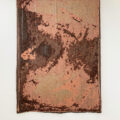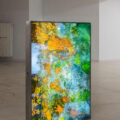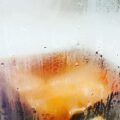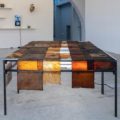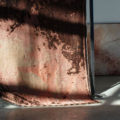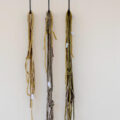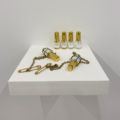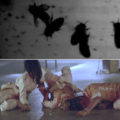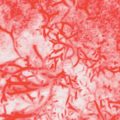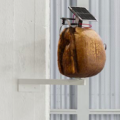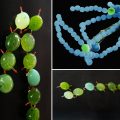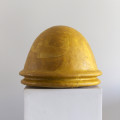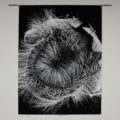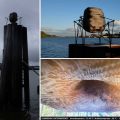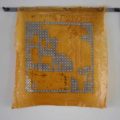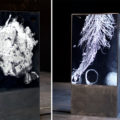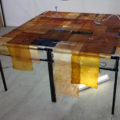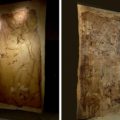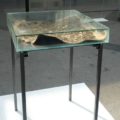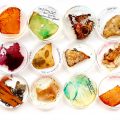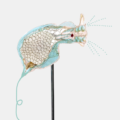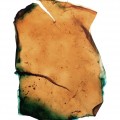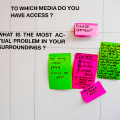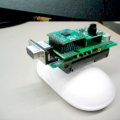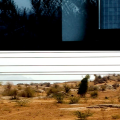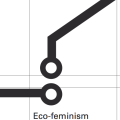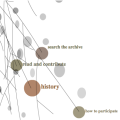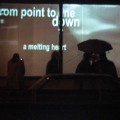
These works are licensed under a Creative Commons Attribution-NonCommercial-NoDerivatives 4.0 International License.
SALINAS d'Addaia (floor sculpture, 2023)
Salt marshes are unique ecosystems at the transition of land and sea. They harbour plants and animals adapted to cope with salt stress. Intertidal salt marshes occur along the edges of shallow seas with soft sediment bottoms where the tidal range is considerable, zones that are flooded regularly by the tides. The obvious coloration of the salt marsh is caused by its microscopic algae,
MICROBIAL ANCESTORS pink (Topography of a Second Skin, textile work, 2023)
Microbial Ancestors (Topography of a Sensorial Skin) -the pink tapestry- is a woven interpretation of a Sensorial Skin. Its topographic view visualizes the ecology of the symbiotic organism composed of Acetobacter xylinum bacteria and Saccharomyces cerevisiae yeast cells and the several layers of cellulose woven by these bacteria to create the skin.
ACUARIO con Acetobacter xylinum (installation, 2023)
In a large aquarium, a fermentation process is taking place. The generative process is in a constant state of transition. The creation of the Sensorial Skin reacts to variable invisible factors as temperature, humidity and the local enzymes in the water and the air. Every newly grown Sensorial Skin is thus the unique result of the specific site were it is grown, with its own metabolism and aesthetic specificities.
MICROBIAL ANCESTORS orange (Topography of a Second Skin, textile work, 2023)
Microbial Ancestors (Topography of a Sensorial Skin) -the pink tapestry- is a woven interpretation of a Sensorial Skin. Its topographic view visualizes the ecology of the symbiotic organism composed of Acetobacter xylinum bacteria and Saccharomyces cerevisiae yeast cells and the several layers of cellulose woven by these bacteria to create the skin.
SENSORIAL SKINS (installations, variable)
Sensorial Skins are grown by bacteria during an acid fermentation process, the result of this action is called 'vegetable leather'. The Sensorial Skins undergo a visible metamorphosis due to the changing invisible factors as temperature and humidity specific to the location.
EXOSKELETON, topography of a second skin (the Winogradski experiment - 2023)
‘Exoskeleton, topography of a second skin’ are 2 lightboxes with photographs of the Winogradski experiment. The experiment researches what bacteria can tell us about the soil they live in. Soil samples (a highly diverse micro-ecosystem of soil bacteria and algae) were cultured for several weeks.
RITUALS with MICROBIAL ANCESTORS (performance, 2023)
Poetry is at the hart of alchemy. Flowers of speech.
Microbial Ancestors, fermentation.
Every death is a birth and every ending is a beginning. Transmutation.
It’s moist and slimy with an acid smell of lively matter.
TABLE WITH SENSORIAL SKINS (installation, 2023)
Since 2015, Anne Marie Maes has been developing organic material by fermenting bacteria and yeasts that leave behind a brownish vegetable leather once removed from their substrate. Expanding, curling, and hardening with the temperature or humidity in the air, these biofilms are called Sensorial Skins to emphasis their living and evolving nature.
PANTONE ALSACE / Reading the Landscape (installation, 2023)
The work 'Pantone Alsace (Reading the Landscape)' is emerging from a meticulously scanned environment. It takes the form of a Pantone colour chart to present a local chromatic range. After several walks to collect plants and fungi in the Alsace region, pigments were extracted to dye the wool which was then woven to obtain a work that bears witness to the "colourful" richness of the regional landscape, offering us a new way of looking at the world.
POEMS FROM A ROOFTOP GARDEN (tapestry works: pink/orange/green, 2023)
A woven topographic view visualizes the ecology of a symbiotic organism. It translates the collaboration between Acetobacter xylinum bacteria and Saccharomyces cerevisiae yeast cells. The original Sensorial Skins were grown in a culture of fresh hibiscus tea for the pink, and campèche-colored tea for the orange. The tapestries offer a play of light shining through the lightly woven,
the LARGE LOOM / Le GRAND METIER (sculpture/performance, 2023)
The Large Loom / Le Grand Métier is a custom-built, two-by-two-meter sculpture in brushed metal. It is a perfectly functional weaving loom that is set in motion by the artist at key points during the exhibition at La Kunsthalle, thereby creating a visual portrait of the region.
MICROBIAL LIFE (installation, 2023)
‘Microbial Life’ focuses on the transformative power of soil bacteria. The installation shows the result of a scientific experiment named ‘Winogradski Columns’. Soil samples (a highly diverse micro-ecosystem of soil bacteria and algae) were cultured for several weeks. The sealed cultures were developing independently over time,
PLEASE TOUCH (objects, 2022)
a Bee is a Bee is a Bee: a durational performance for the Palais the Tokyo, Paris. Commissioned by Vittoria Mataresse, in collaboration with Guerlain Paris and supported by CWB|Paris-hors-les-murs.
SMELL of the HIVE
The video Variation Games is a culmination of the observations carried out between 2017 and 2018 on the community behavior of bees. The images and sound, recorded with an infrared camera and a microphone installed inside the hive, reveal the democratic
a BEE is a BEE is a BEE (performance, 2022)
a Bee is a Bee is a Bee: a durational performance for the Palais the Tokyo, Paris. Commissioned by Vittoria Mataresse, in collaboration with Guerlain Paris and supported by CWB|Paris-hors-les-murs.
At Palais de Tokyo, Anne Marie Maes offers an immersive experience. With an artistic and scientific approach, she transforms the spaces of the Palais into a laboratory.
THE SEA GIVES AND THE SEA WILL TAKE (Theatrum Algaerium - performance video, 2021)
Early in the morning on the fifth day of the harvest month of August 2021.
The beach at Ostend. Bright blue sky. Footprints in a wet sandy beach.
LAMINARIA [webproject]
Laminaria is a website documenting and comparing marine ecosystems in Europe.
Laminaria operates on the border between sapiens and fauna. It outlines possible futures in a new bio/techno/natural world, a universe that is at once terrestrial and aquatic, a prerequisite for future coexistence.
THEATRUM ALGAERIUM (2021)
combining science, fiction and art
Early in the morning and late in the evening, between low and high tide, the Theatrum Algarium rises from the sea. Metal frames hold the fluttering weeds.
ALIEN INTELLIGENCE + BACTERIAL MANTAREY (2021)
'Bacterial Mantarey': this organic sculpture builds upon a body of research that focuses on biofilm formation.
DISAPPEARANCE (2021)
‘Disappearance’ focuses on change and temporality. Five plexiglass boxes are filled with lemons and tangerines that are slowly eaten away by bacteria, until nothing is left. In this degradation process, the organic matter progressively transforms and reduces, till the point of disappearance.
GUERRILLA BEEHIVE (2021)
The ‘Guerrilla Beehive’ is a sculpture & prototype resulting from a speculative research project. Conceived as a mobile shelter for swarming honeybees, it combines in a radical way smart materials, biomimetic forms and biotechnology.
L'ORIGINE DU MONDE II (2021)
Poetically representing extensive research into the potential of cyanobacteria and microalgae, L’origine du monde is composed of a metal structure on which glass cells, filled with cyanobacteria, are growing as they were young, sprouting buds on a tree in springtime.
TERRITORIAL FLOW (2021)
Over a dark metal structure, a soft flow of latex, natural pigments and beeswax mix to create a topographic map. The shapes are reminiscent of the bees’ foraging territory.
TABLE with SKINS (2021)
A selection of bacterial grown skins, microbial cellulose, in different sizes and thickness. Structures are variable. All colored with 100% naturel vegetal dyes, grown in the Brussels Urban Open Air Lab.
PLAY with SQUARES (2021)
Play with Squares is a floor sculpture composed of organically created textiles. They are arranged on a low wooden plinth, and their warm colours are derived from grasses, herbs, vegetables and fruits I grow in my rooftop garden/open-air laboratory. I use organic debris and natural additives to make these colourfield paintings, which evoke to a tranquil, almost meditative contemplation.
TERRITORY#1, assemblage bacterial grown materials
Assemblage made with organic materials. Microbial cellulose skins grown by Acetobacter xylinum and yeast cells, bioplastics with red algae, horse hair. Drawing. Dimensions variable ( 200cm x 120cm)
SHARED GARDENS: a proposition
A project developed for SHARED GARDENS, an exhibition at Magasins Généraux, from June 27 to September 13, in Paris at Pantin on the banks of Ourcq Canal. Focusing on the ecological and social transition, it is aimed at rethinking our ways of living together and our relationship with the environment, starting on a local scale.
SLOW METABOLISM and other objects
The electric green veins running through the bottle are colonies of cyanobacteria. They are slowly evolving and little by little they are colonizing the nutrient gel. They are autotrophe organisms, which means that they provide in their own food. They obtain their energy through oxygenic photosynthesis. They consume CO2 and they release oxygen, similar as plants do.
L'ORIGINE DU MONDE, installation
L’origine du monde is an artistic representation of my research into the possibilities of cyanobacteria and (micro) algae.
The installation shows a strongly enlarged bacterial chain made from glass cells. Every cell is filled with cyanobacteria producing realtime photosynthesis.
ALIEN INTELLIGENCE II, lightboxes
The work consists of a series of SEM (Scanning Electron Micrographs) printed on Duratrans and presented in lightboxes. The black/white micrographs are mixed with lightboxes in which I present colourful microbial cellulose skins (cellulose fabrics made by bacteria and colored by vegetal dyes).
the GOLDEN BEEHIVE, sculpture
We have to think about new materials, inspired by nature. We can experiment with a list of raw materials (list without limitation): corn starch, brown sugar, glutinous rice, coconut fibers, hemp, mushroom mycelium, silk, coffee ground, linen, cotton. We can e.g. cut old natural woven carpets with the lasercutter. We can dye raw materials with color extracts from plants as indigo (from the Indigofera tinctoria) or orange from the Calendula officials.
We can make hives out of flexible solar panels,...
Large scale SCANNING ELECTRON MICROGRAPHS
From the series of Scanning Electron Micrographs: intimate and compelling images on micro-organisms and their (urban) ecosystems, and how these organisms and environments are affected by the era of the anthropocene.
DISRUPTED SENSATIONS - small lightboxes
In my practice, the concept of making and producing the (light)sculptures and textiles is as a form of study. The artistic process happens in layers and is linked to the action of subtracting and adding. The concept of scale is very important. The volume of an object and its relationship with nature (micro/macro) are essential elements of my work. The choice of materials is a primary aspect of my artistic research. I always work with natural and organic components, and...
scale models IGB
A collection of small sculptures, developed during the research of the Intelligent Guerrilla Beehive project (2016-2019). The objects are presented in clear plexi boxes, each 13cm x 13cm x 13cm, on black or white sand. Each piece is unique. Materials: wax, latex, epoxy, bacteria, organic dyes, electronics, 3D printed PLA, seeds, aquarium sand.
![]()
UNTITLED (green and orange wall textile)
Untitled (green + orange wall textile). This piece is made out of fresh and salt water algae collected at the Venice Lagoon, at the Skibotn Fjörd in Norway and they are mixed with microalgae collected on a city rooftop. The orange textile is made from Tangerine skin peels. The work can be presented with or without backlight.
the INTELLIGENT GUERRILLA BEEHIVE 2.0 (algae power)
The project 'Intelligent Guerrilla Beehive 2.0' is researching the renewable energy that can be extracted from algae, to replace the solar panel as an energy source to power the sensors.
'What if' scenario: the environmental information of the foraging fields around the beehive is collected by the sensors in and around the hive, and its data is stored and processed in the cloud.
ELBBIENEN - Intelligent Guerrilla Beehive, Sculpture in Public Space
Honey bees use caves, rock cavities and hollow trees as natural nesting sites. The nest is composed of multiple honeycombs, parallel to each other, with a relatively uniform bee space. It usually has a single entrance. Western honey bees prefer ...
UNTITLED (Yellow - a tribute to Eva Hesse)
Untitled (Yellow, a tribute to Eva Hesse) is part of a series of works with bioplastics in different constallations: multiple layers, a range of organic pigments and testing combinations with different non-organic materials as well introduction and development of bacteria on the bioplastic matrix.
ALCHIMIA NOVA - video
The video, filmed in the studio and open air laboratory of AnneMarie Maes, gives an overview of the different elements of her research.
INTELLIGENT BEEHIVE 2.0 - sculpture with video
the Guerrilla Beehive 2.0 is a speculative project in which the sensors are powered by a cyanobacterial biofilm. The bacteria grow a dense biofilm on the outer shell of the sustainable beehive. The bees are scanning the health of the environment while foraging. When the bees return to...
GLOSSA and STIMULI - b/w micrographs lightboxes
From the series of Scanning Electron Micrographs: intimate and compelling images on micro-organisms and their (urban) ecosystems, and how these organisms and environments are affected by the era of the anthropocene.
TABLE with SKINS - sculpture
A selection of bacterial grown skins, microbial cellulose, in different sizes and thickness. Structures are variable. All colored with 100% naturel vegetal dyes, grown in the Brussels Urban Open Air Lab.
VISIBLE, INVISIBLE - textile works
In my practice, the concept of making and producing the (light)sculptures and textiles is as a form of study. The artistic process happens in layers and is linked to the action of subtracting and adding. The concept of scale is very important. The volume of an object and its relationship with nature (micro/macro) are essential elements of my work.
BACTERIAL MANTAREY - organic sculpture
This organic sculpture builds upon a body of research that focuses on biofilm formation; it is using the aggregation of bacterial colonies as a metaphore for the communication between a diversity of neighborhoods in cities. The biofilm as a city and the city as a biofilm.
A biofilm is an association of micro-organisms in which microbial cells adhere to each other on a living or non-living surface. Biofilm formation is a cooperative group behaviour. The bacteria communicate via quorum sensing
SIGNS OF LIFE - cohabitations
The scientific research of the project Sensorial Skin [for an Intelligent Beehive] focuses on turning the skin into a biosensor. I believe that working with cyanobacteria is a promising path to achieve the objectives regarding the responsive skin, because cyanobacteria are auto-trophe and they can live in colonies and react as such.
ECOLOGICAL FUTURES: Sensorial Sponge
I will investigate in how far a living bacterial sculpture can function as a CO2 reducing and oxygen generating object for use inside the home.
The development of this object will be based upon my previous work with cyanobacteria, I will implement the knowledge that I gathered during my biotech-project ‘Sensorial Skin’ (development of a pollution sensor).
THE INTELLIGENT GUERILLA BEEHIVE / part II
The Intelligent Guerilla Beehive is a bio-art installation on the edge of art and science. It evokes issues of sustainability and biodiversity, giving viewers an artistic experience of my ongoing research related to the disappearance of the honeybee.
Bees are bio-indicators. They reflect the health of their surrounding ecosystem as well...
GENESIS of a MICROBIAL SKIN
'Close reading of the Genesis of a Microbial Skin' gives a condensed overview of my notes (relating to the Intelligent Beehives research with a focus on SKIN) between 2012 to 2017. The project is about growing Intelligent Guerilla Beehives from scratch, with living materials - as nature does. Biomimesis is used as a starting point for incubating ecological thinking on matter and form. Different sensorial qualities of microbial and vegetal SKIN are being examined in terms of usefulness for sensing environmental threaths and for monitoring the wellbeing of the bee colonies.
VARIATION GAMES (video)
VARIATION GAMES are games where the set of rules is constantly adapted by the players.
The bees act as transmitters in an interconnected web of bio-intelligent agents. They construct a bioremedial beehive and create a symbiotic environment for exchange with specific bacteria.
PORTFOLIO OLDER WORK
This Portfolio gives an overview of my work from 1997 to 2009.
Texts and higher resolution images on demand.
NOTOVO - NO2PHO
Voice networks and machine aesthetics: a research into synthetic speech combining litterature and philosophical content. A physical network and a virtual network. People and voices. Wireless headphones and 12 spatialized soundsources. People walk their traject through physical (empty) space and as such localisation data are produced. Synthetic voices are generated and frequency and pitch are modulated by the variable parameters of localisation and orientation. The...
MAHILA/WOMEN - short film
In MAHILA, the filmmaker steps between different worlds, going from West to East, from urban to rural surroundings. Her encounters with the experiences and observations of rural Indian women provoke reflection on the process of empowerment. In an artistic ethnography we see and hear how they are using education, technology and politics to redefine their destinies. As we trace the filmmaker’s memories we are taken into questions about story-telling. How are the women fighting to get their stories h...
POLITICS OF CHANGE - publication
#01_on women empowerment and creative networks
An artistic research project driven by grassroots activism, eco-technology and networks of women to build integrated and sustainable relationships between people, their environment and technology.
My interest in the women Solar Engineers and the Mahila Samiti groups for women’s empowerment in Rajasthan comes out of a personal involvement that links art, women empowerment, ecology, technology and social engagement.
When I learned about the Barefoot College project, I was struck b...
PEOPLE DATABASE - online database project
You can participate in the people database by clicking the tag 'read & contribute'.
Choose an avatar, choose a keyword, and drop your story. You can read the stories of other participants by constulting the database 'search the archive'.
CLOSED CIRCUIT#3
"... You can see just a peep of the passage in Looking-Glass House, if you leave the door of the drawing-room wide open: and it's very like our passage as far as you can see, only you know it may be quite different on beyond. Oh, Kitty, how nice it would be if we could only get through into Looking-Glass House! I'm sure it's got, oh! such beautiful things in it!..." (from the complete works of Lewis Carroll - A wonderland of stories, nonsense and wit.)
CLOSED CIRCUIT#2
Closed Circuit # 2 is a sound installation realized on behalf of the Ministry of the Flemish Community in the income hall of the Boudewijn Building in Brussels.
By analogy with the iconic image of the clocks in international offices or hotels -displaying the real time of important cities-, the installation presents the real time in the cities of New York, Brussels and Tokyo in the form of their own city sounds. Brussels (0 hours), New York (-6 hours), and Tokyo (+8 hours) give together a lapse of twenty-four hours....
